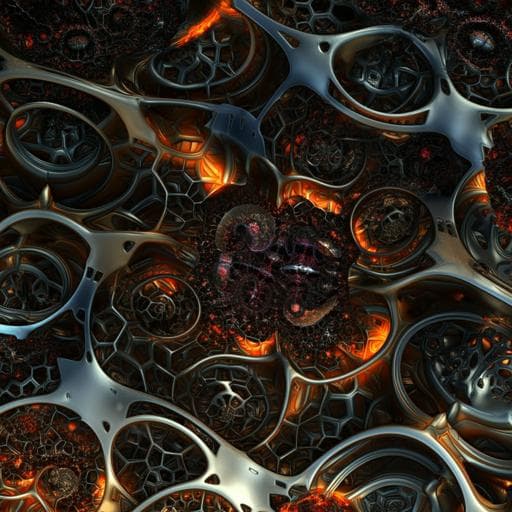
Engineering and Technology
High-throughput design of high-performance lightweight high-entropy alloys
R. Feng, C. Zhang, et al.
Discover how a team of researchers, including Rui Feng and Chuan Zhang, is revolutionizing high-temperature materials through advanced ferritic superalloys. Their innovative use of CALPHAD-based high-throughput computational methods has led to the development of light, strong, and low-cost high-entropy alloys that outperform traditional counterparts at elevated temperatures. This study showcases an efficient strategy for accelerating the discovery of advanced materials tailored for high-performance applications.
~3 min • Beginner • English
Introduction
The study addresses the need for inexpensive, lightweight, and high-strength materials for elevated-temperature applications as alternatives to Ni-base superalloys. Ferritic superalloys with BCC matrices and ordered B2/L21 precipitates offer creep resistance but suffer from insufficient high-temperature strength and weight. High-entropy alloys (HEAs) provide a design paradigm using multiple principal elements to induce lattice distortion and strengthen the matrix. Designing HEAs with coherent intermetallic precipitates (e.g., L21) aims to further enhance strength while maintaining a ductile BCC matrix and low lattice misfit for high precipitate number density. Prior work in the Al–Cr–Fe–Mn–Ti system showed L21 precipitation but detrimental C14 Laves phase formation. The research question is how to efficiently screen the vast composition space to identify lightweight, strong, low-cost HEAs with stable BCC + L21 microstructures over the application temperature range, avoiding brittle phases. The purpose is to deploy a CALPHAD-based high-throughput computational (HTC) workflow coupled with experimental and multiscale modeling validation to discover and understand such alloys.
Literature Review
Decades of development of Ni-base superalloys have advanced aerospace and energy technologies, but further efficiency and environmental goals motivate new materials. Miracle and Senkov and others have established HEA design criteria for high-temperature structural materials, emphasizing stability (no first-order transformations within service temperatures), and microstructures with a ductile solid-solution matrix plus a re-precipitatable strengthening phase. HEA concepts (multi-principal elements) introduce severe lattice distortion that impedes dislocation motion, increasing strength. Coherent intermetallic precipitates (B2, L21) in HEAs have been used to achieve high strength and creep resistance, with low lattice misfit aiding high precipitate densities. Prior Al–Cr–Fe–Mn–Ti HEAs showed coherent L21 precipitates but suffered from brittle C14 Laves phase due to structural/thermal expansion mismatch, limiting properties. Computational approaches (CALPHAD, data mining, multi-objective optimization) have been increasingly used to accelerate HEA discovery, but accuracy depends on databases and computational efficiency.
Methodology
CALPHAD-based high-throughput calculation (HTC):
- Composition space: Al–Cr–Fe–Mn–Ti quinary, 0–50 at.% for each element with 5 at.% step, producing 3246 alloys. Lever-rule model used for solidification calculations to estimate melting temperatures (Tm) and phase stability at Tm.
- Screening criteria: (I) Tm > 1250 °C and single disordered BCC phase at Tm; (II) at 0.8 Tm, f(BCC) + f(L21) = 1 with 0.05 < f(L21) < 0.5; (III) at 0.5 Tm, f(BCC) + f(L21) = 1 with 0.05 < f(L21) < 0.5. Density constraint applied (≤ 6.5 g/cm3) in final selection.
- Workflow: Round 1 solidification HTC (3246 alloys) → 1168 alloys meet criterion I; Round 2 order–disorder (OD) point HTC at 0.8 Tm → 44 alloys meet criterion II; Round 3 OD point HTC at 0.5 Tm → 8 alloys meet criterion III and density limit.
Experimental validation:
- Alloy fabrication: Eight identified compositions arc-melted from 99.9 wt% purity elements, remelted six times, drop-cast; compositions listed in Supplementary Table 1.
- Microstructural characterization: Synchrotron XRD (APS 11-ID-C, 111 keV), SEM/BSE imaging, TEM (FIB-prepared lamellae), dark-field imaging using L21 reflections, HRTEM/FFT; APT (CAMECA LEAP 4000XHR) with laser mode (60 pJ, 30 K base, 0.5% detection rate), reconstruction in IVAS.
- Mechanical testing: Uniaxial compression at room temperature and elevated temperatures (strain rate 2×10−3 s−1), cylinders 3 mm diameter × 6 mm length, triplicate tests.
- In situ neutron experiments: Neutron diffraction under compression (VULCAN, SNS, ORNL) with HR mode; event-based data reduction via VDRIVE; total scattering and pair distribution function (PDF) (NOMAD, SNS) from RT to ~1080 °C, vacuum, 10 °C/min ramp, 24 min holds; PDF fitted via PDFgui.
Multiscale modeling:
- Metropolis Monte Carlo (MC): Lattice-gas model on BCC lattice with nearest-neighbor interactions J_ij = ΔH_ij/z (z=4), ΔH_ij from AFLOW database; simulations for Alloys 1 and 7 (2000 atoms, 10^7 steps) to compute long-range order (LRO) and short-range order (SRO) vs temperature; additional simulation for L12 reference (250 atoms, 10^6 steps). LRO parameter η_i = (y_i^α − y_i^β)/(y_i^α + y_i^β).
- Ab initio molecular dynamics (AIMD): VASP, canonical ensemble, PAW, PBE, spin polarization, 350 eV cutoff, single k-point, 200-atom cubic cell; 1 fs timestep, Nose thermostat; liquid structure at 1600 °C with zero-pressure volume; hybrid MC/MD sampling; partial pair distribution functions (PDFs) computed to analyze bonding preferences.
Additional analyses:
- Derivation of strengthening contributions (ordering strengthening, load transfer) via in situ neutron diffraction and micromechanical interpretation.
- Atomic site occupancy rules for multicomponent L21 derived from MC ordering results and AIMD pair correlations, correlating compositions to L21 morphologies (nanoscale precipitates vs L21 antiphase domains).
Key Findings
High-throughput screening outcomes:
- Screened 3246 Al–Cr–Fe–Mn–Ti compositions (5 at.% grid). 1168 met Tm > 1250 °C and single BCC at Tm (criterion I). 44 met criterion II at 0.8 Tm. 8 alloys met all three criteria with density ≤ 6.5 g/cm3.
Microstructure:
- All eight alloys (as-cast) contain BCC and/or ordered L21 without other intermetallics by synchrotron XRD.
- Two morphology groups:
• G1 (Alloys 1: Al20Cr5Fe50Mn20Ti5; 8: Al15Cr5Fe50Mn25Ti5): BCC matrix with high-density, coherent nanoscale L21 precipitates (10–30 nm; ~39 nm after 1200 °C anneal). Alloy 1 L21 volume fraction ~44 vol.% (APT and Rietveld); precipitate number density ~2.76×10^22 m−3 (underestimated due to overlap). APT: L21 enriched in Al and Ti; BCC enriched in Cr, Mn, Fe.
• G2 (Alloys 2–7): Predominantly ordered L21 forming antiphase domains (APDs) separated by BCC films at APBs; APDs coarsen upon annealing (e.g., 700 °C, 2 h).
Mechanical properties:
- Room-temperature compression yield strengths span ~500–1642 MPa among eight alloys.
- Elevated temperature (as-cast):
• Alloy 1: 1072 ± 25 MPa at 600 °C; 607 ± 22 MPa at 700 °C.
• Alloy 8: 1032 ± 10 MPa at 600 °C; 643 ± 16 MPa at 700 °C.
- Alloys 1 and 8 show higher yield and specific yield strengths than traditional BCC-based precipitation-strengthened alloys (BCC+L21, BCC+D03, BCC+B2) up to ~700 °C.
- In situ neutron diffraction under load shows clear load transfer in Alloy 1: hard L21 bears higher lattice strains after BCC yields (~1000 MPa); no load transfer in Alloy 7, consistent with single-phase L21-like behavior.
Order–disorder transitions:
- In situ neutron total scattering: Alloy 1 retains L21 superstructure peaks up to ~900 °C (coexistence of BCC+L21 below 900 °C). Alloy 7 shows L21 order peaks up to 1050 °C.
- MC simulations: Ordering temperatures (from LRO): Alloy 1 T0 ≈ 1607 °C (1880 K); Alloy 7 T0 ≈ 1997 °C (2270 K, above its melting point). SRO trends show Al, Ti, Cr prefer one sublattice; Fe, Mn the other.
- AIMD partial PDFs at 1600 °C indicate strong Al–Fe and Cr–Fe pair correlations, supporting formation of L21 and BCC, respectively; weak Al–Al and Ti–Ti correlations.
Composition–structure rule:
- Atomic site occupancy in multicomponent L21 (X2YZ): Fe occupies X(8c) (up to 50 at.% Fe); Al fills Y(4a); Ti/Cr (and excess Al if Al > 25 at.%) fill Z(4b); Mn fills remaining X(8c) if Fe < 50 at.%, otherwise limited solubility on Z(4b) up to ~15 at.% Mn. Cr tends to segregate with Fe/Mn in BCC.
- Compositions close to ideal L21 stoichiometry favor single-phase L21 (APDs, G2); deviations produce BCC + nanoscale L21 precipitates (G1).
Discussion
The integrated CALPHAD-based HTC, combined with multiscale modeling and experiments, effectively identified precipitation-strengthened lightweight HEAs with superior strength and specific strength at room and elevated temperatures. The findings directly address the design goal of obtaining BCC-matrix alloys with stable L21 precipitates across the application temperature range, while avoiding brittle phases. Experimental validations confirmed predicted phase constituents for the best-performing alloys, and in situ neutron diffraction revealed operative strengthening via load transfer and ordering effects. MC and AIMD clarified the order–disorder behavior and atomic site occupancy, explaining why certain compositions yield nanoscale precipitates (optimal for strengthening) whereas others form predominant L21 APDs. This mechanistic understanding feeds back to refine CALPHAD databases (particularly L21 stability) and to couple HTC with composition–occupancy rules for more targeted screening. The alloys outperform several traditional BCC precipitation-strengthened systems up to ~700 °C, and insights from Ni-base superalloy design (e.g., minor refractory additions) are suggested to further enhance softening resistance above 700 °C.
Conclusion
A CALPHAD-based high-throughput workflow successfully discovered eight lightweight Al–Cr–Fe–Mn–Ti HEAs satisfying stringent high-temperature criteria, with two compositions (Alloys 1 and 8) exhibiting a BCC matrix strengthened by coherent nanoscale L21 precipitates and achieving high yield strengths at 600–700 °C. The study elucidates order–disorder transitions, atomic site occupancies, and composition–morphology relations that govern L21 formation and strengthening, and demonstrates the value of integrating HTC with in situ neutron scattering, APT, TEM, AIMD, and MC simulations. These advances enable accelerated discovery of precipitation-strengthened lightweight HEAs and provide rules for composition selection to achieve desired microstructures. Future work should include refining thermodynamic databases for L21 stability via extended annealing studies and quantitative phase analysis, coupling HTC with the derived occupancy/morphology rules for more efficient searches, and exploring minor refractory alloying to improve high-temperature softening resistance.
Limitations
The accuracy of predictions depends on the thermodynamic database; discrepancies between predicted and observed phase fractions (e.g., single-phase L21 in some alloys) indicate the need to improve L21 stability descriptions. The HTC screening used a 5 at.% compositional grid; finer grids (e.g., 1 at.%) greatly increase computational cost. The current validated composition rules are most reliable within Al ≤ 25 at.% and Mn ≤ 15 at.% with other elements fixed; generalization beyond this range requires further study. The precipitate number density measured by APT may be underestimated due to overlapping features. High-temperature softening above ~700 °C remains a challenge and requires additional alloying strategies.
Related Publications
Explore these studies to deepen your understanding of the subject.







